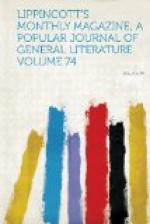SKETCHES OF INDIA.
III.
Thus we fared leisurely along. We passed Cabul merchants peddling their dried fruit on shaggy-haired camels; to these succeeded, in more lonesome portions of the road, small groups of Korkas, wretched remnants of one of the autochthonal families of Central India—even lower in the scale of civilization than the Gonds, among whom they are found; and to these the richly-caparisoned elephants of some wealthy Bhopal gentleman making a journey. We lingered long among the marvelous old Buddhistic topes or tumuli of Sanchi, and I interested my companion greatly in describing the mounds of the United States, with which I was familiar, and whose resemblance to these richly-sculptured and variously-ornamented ruins, though rude and far off, was quite enough to set his active fancy to evolving all manner of curious hypotheses going to explain such similarity. The whole way, by Sangor, Gharispore, Bhilsa, Sanchi, Sonori, presented us with the most interesting relics of the past, and the frequent recurrence of the works of the once prevalent Buddhistic faith continually incited us to new discussions of the yet unsolved question, Why has Buddha’s religion, which once had such entire possession of this people’s hearts, so entirely disappeared from the land?
And, as nothing could be more completely contrasted with the desert asceticism which Buddha’s tenets inculcated than the luxury into which Mohammed’s creed has flowered, so nothing could have more strikingly broken in upon our discussions of the Buddhistic monuments than the view which we at last obtained of the lovely Mohammedan city of Bhopal. To the south and east ran a strip of country as barren and heartacheish as if the very rocks and earth had turned Buddhist, beyond which a range of low rounded hills, not unlike topes, completed the ascetic suggestion. But, turning from this, we saw Mohammedanism at its very loveliest. Minarets, domes, palaces, gardens, the towers of the citadel, waters of lovely lakes, all mingled themselves together in the voluptuous light of the low sun: there was a sense of music, of things that sparkled, of pearly lustres, of shimmering jewels, of softness, of delight, of luxury. Bhopal looked over the ragged valley like a sultan from the window of his zenana regarding afar off an unkempt hermit in his solitude. My companion had arranged for permission to enter the town, and it was not long ere we were installed in the house of a friend of Bhima Gandharva’s, whose guests we remained during our stay in Bhopal.
[Illustration: MUSSULMAN WOMAN OF BHOPAL.]




